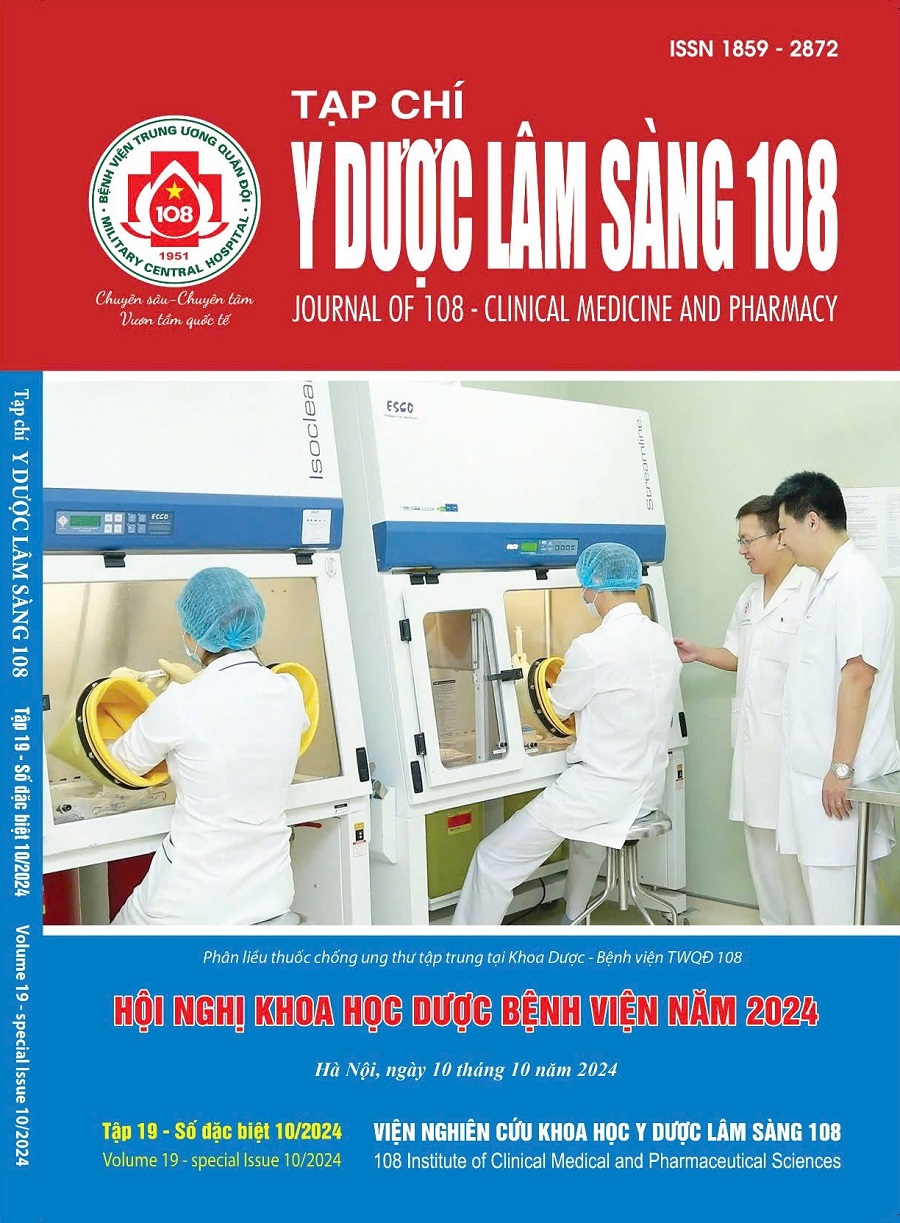Evaluation of the effectiveness of some interventions to reduce hospital-acquired infections in Intensive Care Units, 108 Military Central Hospital
Main Article Content
Keywords
Abstract
Objective: To evaluate the effectiveness of some measures to improve hand hygiene and screening and isolation of patients carrying carbapenem-resistant enterobacteria (CRE) in reducing hospital-acquired infections in intensive care units (ICUs), 108 Military Central Hospital. Subject and method: Interventional study to improve hand hygiene and actively screen for CRE and isolate patients carrying CRE on 450 patients treated in ICUs. Result: Before intervention: The rate of hospital-acquired infections in patients treated in ICUs was 30.4%, the rate of CRE carriage when screened at the time of admission was 30.77%, at the time of discharge was 84.9%, the duration of CRE infection was 9-12 days. After intervention: The rate of hospital-acquired infections decreased to 17.7%, the rate of CRE carriage at the time of discharge decreased to 52.5%, the delay time of CRE infection was longer (13-24) days. The isolated CRE mainly included K. pneumoniae (47.08%), E. coli (23.2%), E. cloace 5.71%. The carbapenemase coding genes through rapid testing of K. pneumoniae mainly included KPC and NDM, of E. coli mainly included OXA and NDM. Conclusion: The rate of hospital-acquired infections in ICUs before intervention was still high. Implementing measures to enhance hand hygiene, screening and isolating patients carrying CRE reduced the rate of CRE infection and hospital-acquired infections in ICUs.
Article Details
References
2. Lewnard JA, Charani E, Gleason A, Hsu LY, Khan WA, Karkey A, Chandler CIR, Mashe T, Khan EA, Bulabula ANH, Donado-Godoy P, Laxminarayan R (2024) Burden of bacterial antimicrobial resistance in low-income and middle-income countries avertible by existing interventions: An evidence review and modelling analysis. Lancet 403(10442): 2439-2454.
3. Mendelson M, Lewnard JA, Sharland M, Cook A, Pouwels KB, Alimi Y, Mpundu M, Wesangula E, Weese JS, Røttingen JA, Laxminarayan R (2024) Ensuring progress on sustainable access to effective antibiotics at the 2024 UN General Assembly: A target-based approach. Lancet 403(10443): 2551-2564.
4. McKinn S, Trinh DH, Drabarek D, Trieu TT, Nguyen PTL, Cao TH, Dang AD, Nguyen TA, Fox GJ, Bernays S (2021) Drivers of antibiotic use in Vietnam: implications for designing community interventions. BMJ Glob Health 6(7):e005875. doi: 10.1136/bmjgh-2021-005875.
5. Carrique-Mas JJ, Choisy M, Van Cuong N, Thwaites G, Baker S (2020) An estimation of total antimicrobial usage in humans and animals in Vietnam. Antimicrob Resist Infect Control 9(1): 16.
6. Depuydt PO, Vandijck DM, Bekaert MA, Decruyenaere JM, Blot SI, Vogelaers DP, Benoit DD (2008) Determinants and impact of multidrug antibiotic resistance in pathogens causing ventilator-associated-pneumonia. Crit Care
12(6): 142.
7. Falcone M, Russo A, Iacovelli A, Restuccia G, Ceccarelli G, Giordano A, Farcomeni A, Morelli A, Venditti M (2016) Predictors of outcome in ICU patients with septic shock caused by Klebsiella pneumoniae carbapenemase-producing K. pneumoniae. Clin Microbiol Infect 22(5):444-50. doi: 10.1016/j.cmi.2016.01.016.
8. Tran DM, Larsson M, Olson L, Hoang NTB, Le NK, Khu DTK, Nguyen HD, Vu TV, Trinh TH, Le TQ, Phan PTT, Nguyen BG, Pham NH, Mai BH, Nguyen TV, Nguyen PTK, Le ND, Huynh TM, Anh Thu LT, Thanh TC, Berglund B, Nilsson LE, Bornefall E, Song LH, Hanberger H (2019) High prevalence of colonisation with carbapenem-resistant Enterobacteriaceae among patients admitted to Vietnamese hospitals: Risk factors and burden of disease. J Infect 79(2): 115-122.
9. Weiner-Lastinger LM, Abner S, Edwards JR, Kallen AJ, Karlsson M, Magill SS, Pollock D, See I, Soe MM, Walters MS, Dudeck MA (2020) Antimicrobial-resistant pathogens associated with adult healthcare-associated infections: Summary of data reported to the National Healthcare Safety Network, 2015-2017. Infect Control Hosp Epidemiol 41(1): 1-18.
10. Bredin S, Charpentier J, Mira JP, Gastli N, Pène F, Llitjos JF (2022) Impact of colonization with multidrug-resistant bacteria on the risk of ventilator-associated pneumonia in septic shock. J Crit Care 71: 154068.
11. Göttig S, Walker SV, Saleh A, Koroska F, Sommer J, Stelzer Y, Steinmann J, Hamprecht A (2020) Comparison of nine different selective agars for the detection of carbapenemase-producing Enterobacterales (CPE). Eur J Clin Microbiol Infect Dis 39(5): 923-927.
12. H’ Nương Niê, Phạm Hồng Nhung, Trần Minh Châu, Vũ Ngọc Hiếu, Lại Đức Trường (2023) Xác định kiểu gen mã hóa carbapenemase của các chủng Klebsiella pneumoniae sinh carbapenemase chưa phân nhóm được bằng hệ thống Phoenix M50. Tạp chí Nghiên cứu Y học 160(12V1), tr. 1-7.
 ISSN: 1859 - 2872
ISSN: 1859 - 2872
